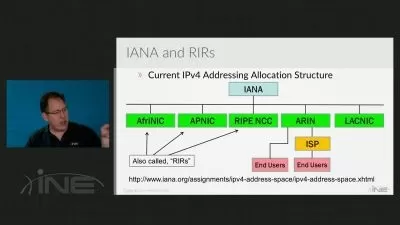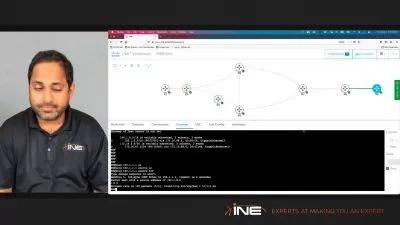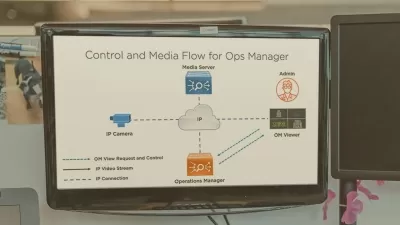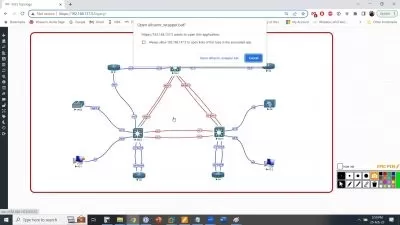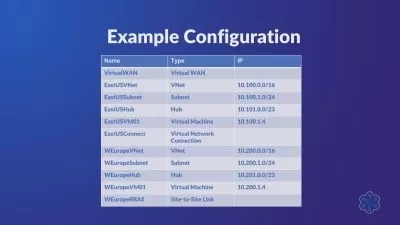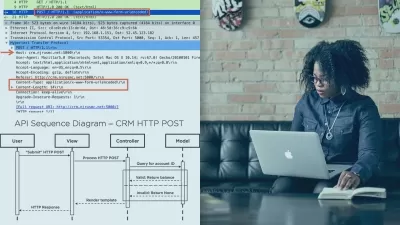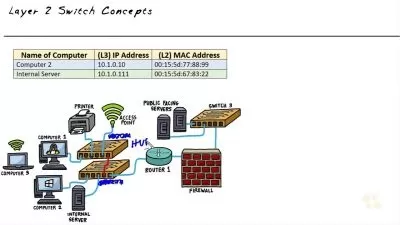IP Services HSRP, VRRP & GLBP
ZB Networks 50000+ students trained Worldwide
1:40:31
Description
Implementing First Hop Redundancy Protocol (HSRP, VRRP & GLBP)
What You'll Learn?
- Overview of Different Redundancy Protocols
- Implementing HSRP
- Implementing VRRP
- Implementing GLBP
Who is this for?
What You Need to Know?
More details
DescriptionFirst Hop Redundancy Protocol (FHRP)
IP routing redundancy is designed to allow for transparent fail-over at the first-hop IP router.
Both HSRP and VRRP enable two or more devices to work together in a group, sharing a single IP address, the virtual IP address. The virtual IP address is configured in each end user's workstation as a default gateway address and is cached in the host's Address Resolution Protocol (ARP) cache.
In an HSRP or VRRP group, one router is elected to handle all requests sent to the virtual IP address. With HSRP, this is the active router. An HSRP group has one active router, at least one standby router, and perhaps many listening routers. A VRRP group has one active router and one or more backup routers.
HSRP protocol:
Hot Standby Router Protocol (HSRP) is a Cisco proprietary protocol that allows two or more routers to work together to present the appearance of a single virtual router to the hosts on a LAN. HSRP provides redundancy, load balancing, and automatic failover in case of a router failure.
In HSRP, one router is elected as the active router, and another router is elected as the standby router. The active router is responsible for forwarding packets sent to the virtual IP address, and the standby router monitors the active router and takes over the forwarding role if the active router fails. The virtual IP address is assigned to the active router, and it responds to ARP requests for that IP address.
HSRP also supports the concept of a preemption, which means that if a higher priority router becomes available on the network, it can preempt the current active router and become the new active router. HSRP also supports load balancing by allowing multiple routers to share the forwarding of packets sent to the virtual IP address.
HSRP is commonly used in enterprise networks, especially in mission-critical environments, to provide redundancy and ensure high availability of network services.
VRRP protocol:
Virtual Router Redundancy Protocol (VRRP) is a standards-based protocol that provides redundancy and failover capabilities for IP networks. Like HSRP, VRRP allows multiple routers to work together to present the appearance of a single virtual router to hosts on a LAN. However, unlike HSRP, VRRP is not vendor-specific and can be used on a variety of network devices from different manufacturers.
In VRRP, the routers that participate in the protocol elect one router as the master router and the other routers as backup routers. The master router is responsible for forwarding packets sent to the virtual IP address, and the backup routers monitor the master router and take over the forwarding role if the master router fails. The virtual IP address is assigned to the master router, and it responds to ARP requests for that IP address.
VRRP also supports the concept of a preemptive router, which means that if a higher priority router becomes available on the network, it can preempt the current master router and become the new master router. Additionally, VRRP supports load balancing by allowing multiple routers to share the forwarding of packets sent to the virtual IP address.
VRRP is commonly used in enterprise networks, especially in mission-critical environments, to provide redundancy and ensure high availability of network services.
GLBP proptocol:
Gateway Load Balancing Protocol (GLBP) is a Cisco proprietary protocol that provides redundancy and load balancing capabilities for IP networks. GLBP allows multiple routers to work together to present the appearance of a single virtual gateway IP address to hosts on a LAN, while also distributing the traffic load across multiple routers.
In GLBP, the routers that participate in the protocol elect one router as the active virtual forwarder (AVF) and the other routers as backup virtual forwarders (BVF). The AVF is responsible for forwarding packets sent to the virtual IP address, and the BVFs share the forwarding load by forwarding packets for virtual MAC addresses assigned by the AVF. The virtual IP address and virtual MAC addresses are assigned to the AVF, and it responds to ARP requests for those addresses.
GLBP also supports the concept of a preemptive router, which means that if a higher priority router becomes available on the network, it can preempt the current AVF and become the new AVF. Additionally, GLBP allows for load balancing by using a variety of load-balancing algorithms, including round-robin, weighted, and host-dependent.
GLBP is commonly used in enterprise networks, especially in environments where there is high demand for network services and redundancy is crucial. GLBP can help optimize network performance and reduce the risk of service disruptions by distributing traffic load across multiple routers while providing redundancy and failover capabilities.
Table of content:
Introduction
IP Services Overview
Overview of HSRP, VRRP and GLBP
HSRP Lab
Configuring HSRP Tracking
Load Sharing with HSRP
Implementing VRRP
Implementing GLBP
Who this course is for:
- Anyone who wishes to learn how HSRP, VRRP & GLBP is implemented
First Hop Redundancy Protocol (FHRP)
IP routing redundancy is designed to allow for transparent fail-over at the first-hop IP router.
Both HSRP and VRRP enable two or more devices to work together in a group, sharing a single IP address, the virtual IP address. The virtual IP address is configured in each end user's workstation as a default gateway address and is cached in the host's Address Resolution Protocol (ARP) cache.
In an HSRP or VRRP group, one router is elected to handle all requests sent to the virtual IP address. With HSRP, this is the active router. An HSRP group has one active router, at least one standby router, and perhaps many listening routers. A VRRP group has one active router and one or more backup routers.
HSRP protocol:
Hot Standby Router Protocol (HSRP) is a Cisco proprietary protocol that allows two or more routers to work together to present the appearance of a single virtual router to the hosts on a LAN. HSRP provides redundancy, load balancing, and automatic failover in case of a router failure.
In HSRP, one router is elected as the active router, and another router is elected as the standby router. The active router is responsible for forwarding packets sent to the virtual IP address, and the standby router monitors the active router and takes over the forwarding role if the active router fails. The virtual IP address is assigned to the active router, and it responds to ARP requests for that IP address.
HSRP also supports the concept of a preemption, which means that if a higher priority router becomes available on the network, it can preempt the current active router and become the new active router. HSRP also supports load balancing by allowing multiple routers to share the forwarding of packets sent to the virtual IP address.
HSRP is commonly used in enterprise networks, especially in mission-critical environments, to provide redundancy and ensure high availability of network services.
VRRP protocol:
Virtual Router Redundancy Protocol (VRRP) is a standards-based protocol that provides redundancy and failover capabilities for IP networks. Like HSRP, VRRP allows multiple routers to work together to present the appearance of a single virtual router to hosts on a LAN. However, unlike HSRP, VRRP is not vendor-specific and can be used on a variety of network devices from different manufacturers.
In VRRP, the routers that participate in the protocol elect one router as the master router and the other routers as backup routers. The master router is responsible for forwarding packets sent to the virtual IP address, and the backup routers monitor the master router and take over the forwarding role if the master router fails. The virtual IP address is assigned to the master router, and it responds to ARP requests for that IP address.
VRRP also supports the concept of a preemptive router, which means that if a higher priority router becomes available on the network, it can preempt the current master router and become the new master router. Additionally, VRRP supports load balancing by allowing multiple routers to share the forwarding of packets sent to the virtual IP address.
VRRP is commonly used in enterprise networks, especially in mission-critical environments, to provide redundancy and ensure high availability of network services.
GLBP proptocol:
Gateway Load Balancing Protocol (GLBP) is a Cisco proprietary protocol that provides redundancy and load balancing capabilities for IP networks. GLBP allows multiple routers to work together to present the appearance of a single virtual gateway IP address to hosts on a LAN, while also distributing the traffic load across multiple routers.
In GLBP, the routers that participate in the protocol elect one router as the active virtual forwarder (AVF) and the other routers as backup virtual forwarders (BVF). The AVF is responsible for forwarding packets sent to the virtual IP address, and the BVFs share the forwarding load by forwarding packets for virtual MAC addresses assigned by the AVF. The virtual IP address and virtual MAC addresses are assigned to the AVF, and it responds to ARP requests for those addresses.
GLBP also supports the concept of a preemptive router, which means that if a higher priority router becomes available on the network, it can preempt the current AVF and become the new AVF. Additionally, GLBP allows for load balancing by using a variety of load-balancing algorithms, including round-robin, weighted, and host-dependent.
GLBP is commonly used in enterprise networks, especially in environments where there is high demand for network services and redundancy is crucial. GLBP can help optimize network performance and reduce the risk of service disruptions by distributing traffic load across multiple routers while providing redundancy and failover capabilities.
Table of content:
Introduction
IP Services Overview
Overview of HSRP, VRRP and GLBP
HSRP Lab
Configuring HSRP Tracking
Load Sharing with HSRP
Implementing VRRP
Implementing GLBP
Who this course is for:
- Anyone who wishes to learn how HSRP, VRRP & GLBP is implemented
User Reviews
Rating
ZB Networks 50000+ students trained Worldwide
Instructor's Courses
Udemy
View courses Udemy- language english
- Training sessions 8
- duration 1:40:31
- English subtitles has
- Release Date 2023/07/30







